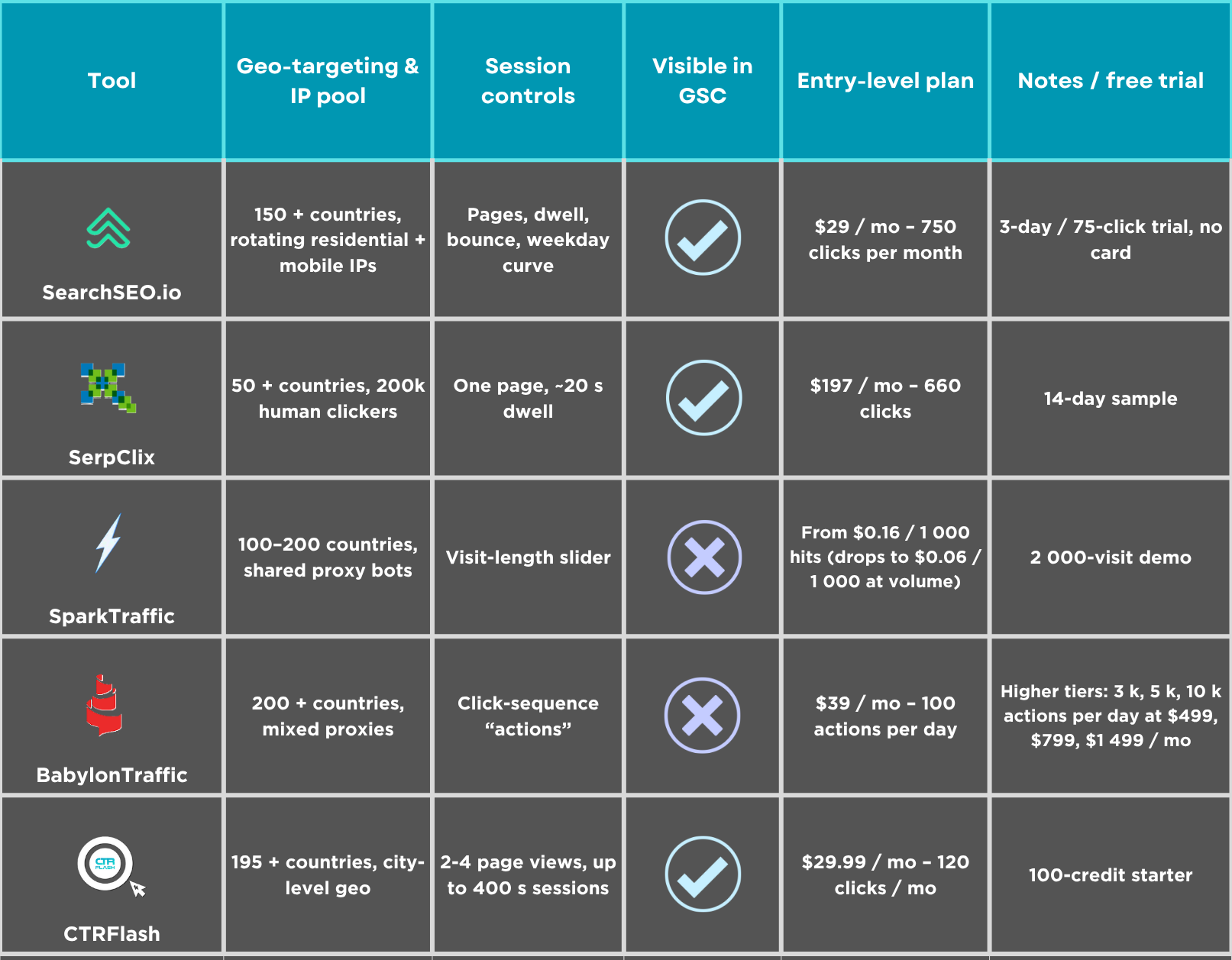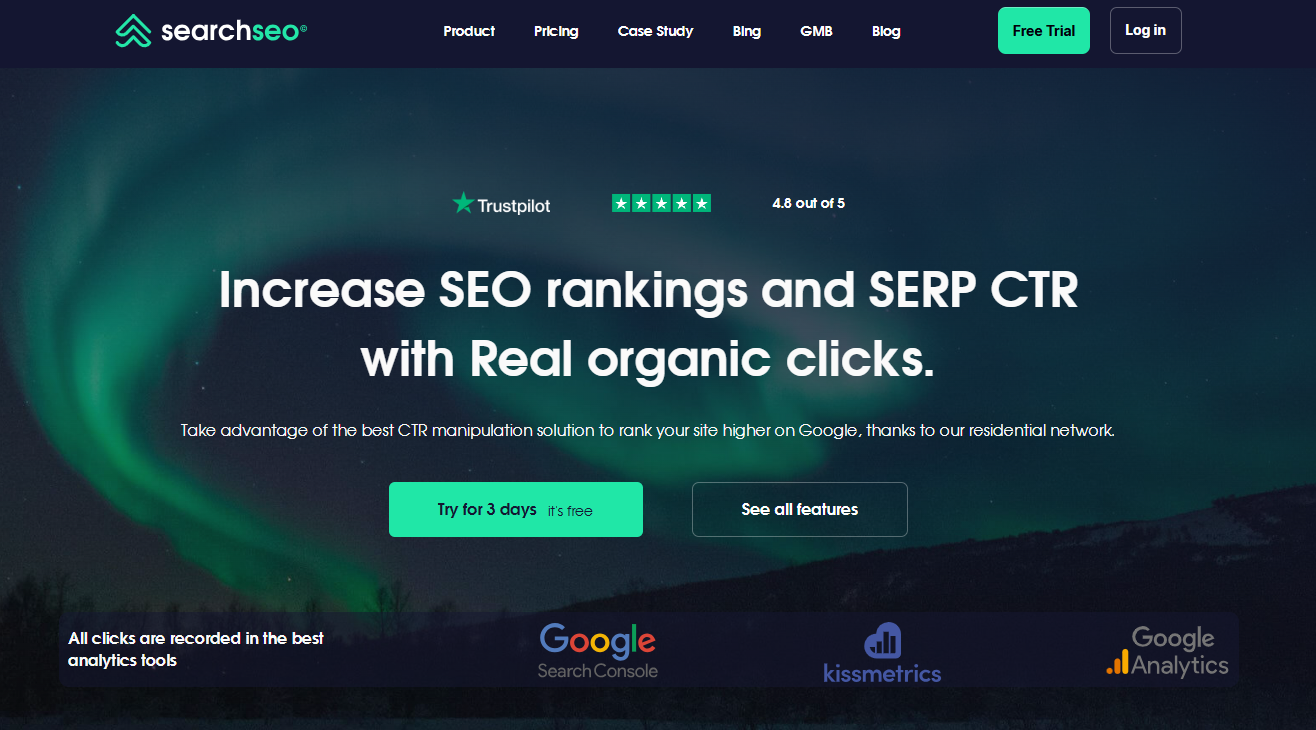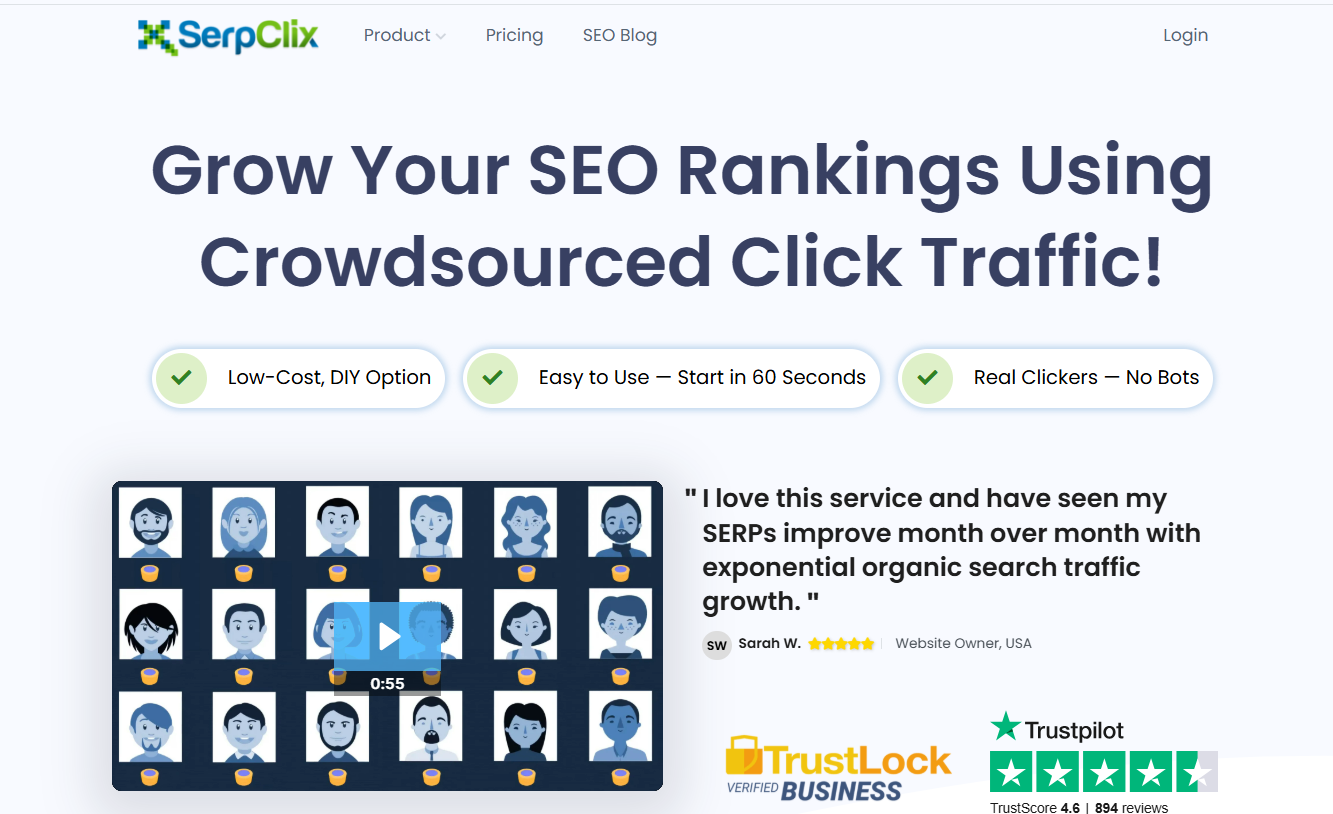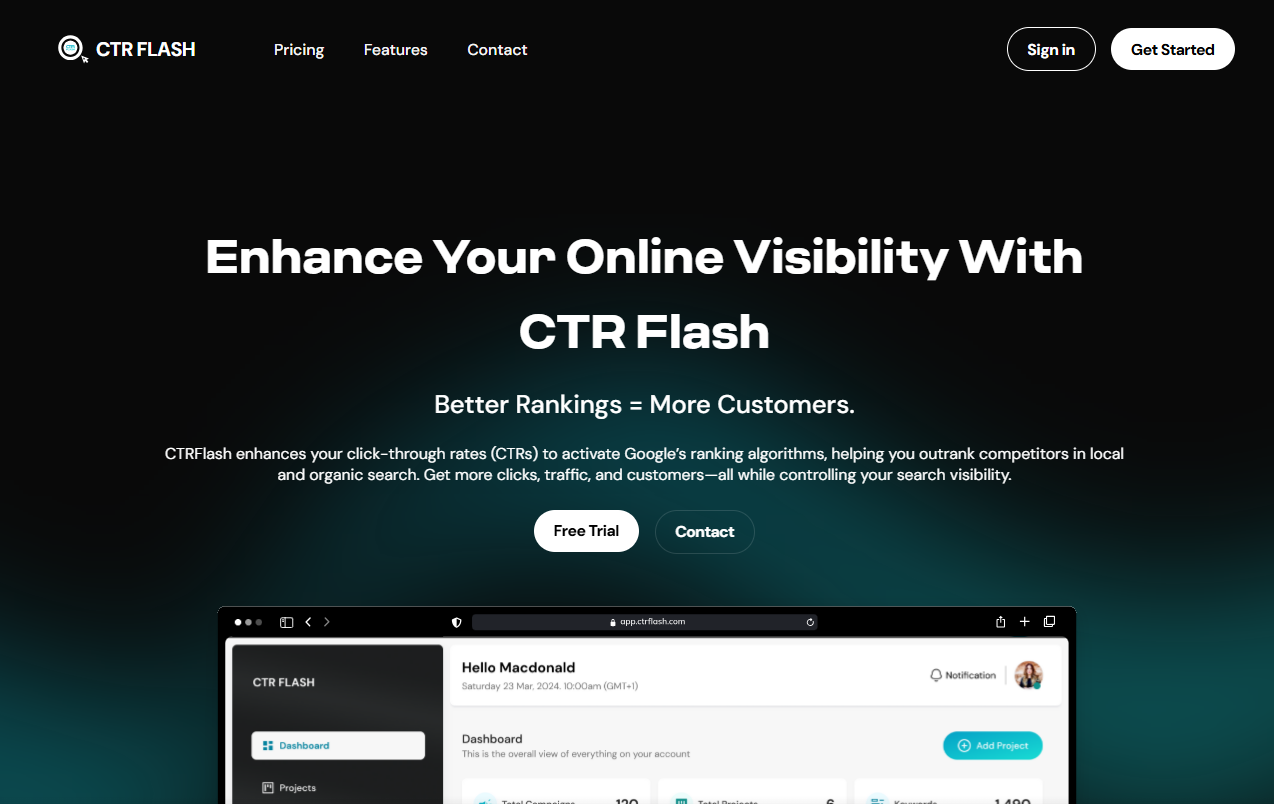Best Traffic Bot 2026: Which Tool Drives the Most Clicks?
Explore the best traffic bots of 2025, compare features, geo-targeting, and pricing so you can pick the perfect tool to drive real, Google-counted clicks.
.svg)

.svg)
%201.png)



Explore the best traffic bots of 2025, compare features, geo-targeting, and pricing so you can pick the perfect tool to drive real, Google-counted clicks.
.svg)

.svg)
%201.png)



Traffic bots aren’t shady hacks by default—they’re simply tools. Used strategically, they kick-start engagement signals that would otherwise take months to build. Used recklessly, they trip every spam filter in sight. The trick is knowing when to push the gas and when to ease off.
Used smartly, a traffic bot is like putting premium fuel in your ranking engine. You give Google stronger engagement signals without waiting months for organic volume to catch up.
Think augmentation. Limit bot sessions to a small slice of your real traffic, schedule them during normal user hours, and mimic natural behavior (scrolling, multiple pages, 45-60 sec dwell time). Stick to that formula, and you’re enhancing genuine user intent—not fabricating it.
Google’s algorithm is essentially a giant satisfaction survey. The right traffic-bot strategy makes sure your answers score high.
Track these metrics in Google Search Console and GA4 as your campaign runs. When you see steady gains—and no warning spikes—you’ll know your traffic bot is amplifying the right signals and laying the groundwork for sustainable, human-driven growth.
Picking a traffic-bot tool isn’t just about raw visit numbers—it’s about feeding Google the right signals while protecting your brand (and budget). Below are the four checkpoints savvy SEOs use. Spoiler: SearchSEO.io nails every one, but we’ll show you what to look for so you can judge for yourself.
Google tracks far more than raw clicks. A believable session looks like this:
SearchSEO.io lets you dial in every one of those metrics—right from the dashboard you see above:
Every click lands, lingers, scrolls, and exits just like a human—keeping Google happy and your engagement metrics sparkling.
A flood of visits is meaningless unless you can tie every click to rank movement and revenue. Your traffic-bot platform should:
SearchSEO.io treats analytics like a first-class citizen:
Bottom line, if a traffic bot can’t prove its value in the same analytics tools you trust for organic SEO, keep shopping.
1. Boosting search rankings (CTR manipulation)
Search engines look at click-through rate (CTR) and on-page engagement as “quality” signals. A traffic bot can:
These tactics fall under grey hat SEO—they aren’t strictly forbidden, but they push the boundaries of what’s considered acceptable by search engines.
2. Load- and stress-testing your infrastructure
Before a product launch or big campaign, you need to know how much traffic your stack can handle. Bots make that painless:
Used responsibly, traffic bots are both a growth lever (CTR gains) and an insurance policy (capacity planning). Misused, they’re just empty numbers—so match the tool to the job and keep the goals clear.

SearchSEO isn’t a generic “traffic bot.” It’s a purpose-built CTR-optimization platform that sends keyword-targeted, geo-specific traffic and clicks from real residential and 4G mobile IPs, the same footprint Google expects from human visitors.

Bottom line: If you want more than vanity page views—if you need measurable lifts in click-through rate and rankings—SearchSEO.io delivers premium, Google-visible traffic at an entry-level price. Start your free 3-day trial and see the difference after just 75 clicks.
SerpClix is a crowdsourced-click platform that routes real human searchers—150,000-plus residential users spread across 50 + countries—to your chosen keywords. Because each participant uses their own device and IP (no VPNs or datacenter proxies), every click looks authentic to Google: the searcher enters the query, scrolls the results, and taps your listing, so impressions and clicks register in Google Search Console just like organic traffic. Plans start at $197 per month for roughly 660 clicks (6,000 credits), and new users can sample a limited “Start-my-Trial” offer before committing.

Below are five quick takeaways:
Verdict: SerpClix shines when you need undeniable “human” clicks in small batches—perfect for testing or nudging a handful of mid-pack keywords. If you’re after deeper session customization (pages visited, dwell-time control, weekday curves) or large-scale CTR lifts at a lower cost, SearchSEO.io remains the more flexible, budget-friendly choice.
This bot bills itself as a “website-traffic generator,” but what it really delivers is a flood of page-views that show up only in Google Analytics. Most plans route automated browsers through rotating lists of free datacenter proxies, spoof the referrer, and never start in the SERP, so Google Search Console records zero impressions or clicks. The company openly guarantees visibility only in GA, unless you upgrade to a premium “Search Console Traffic” add-on (independent proof of that feature is sparse).

Entry pricing is aggressive—about $9.99 per month for 10,000 visits—which makes the service popular for vanity metrics or server stress-testing, not for serious SEO work. Because the same proxy/fingerprint combo can repeat thousands of times, Google can detect the pattern, ignore the sessions, or even flag quality issues.
Five quick takeaways:
Bottom line: SparkTraffic is perfect when you just need big, cheap numbers in Google Analytics. If your goal is sustainable ranking growth or trustworthy engagement metrics, look elsewhere—SparkTraffic alternative tools like SearchSEO.io provide real CTR signals at only a slightly higher cost.
BabylonTraffic positions itself as a “traffic-bot builder,” giving you surgical control over how each fake visitor behaves. You can script a journey—wait 60 seconds → click product page → hit add-to-cart—then decide exactly where those users come from (every country on the map) and which referrer appears in your analytics.

The platform relies on two IP pools: dedicated servers that spoof an IP just for Google Analytics and an optional tier of residential proxies that look more natural online. Entry pricing starts at $39 per month for the Newcomer plan, which supplies about 100 actions per day across up to three campaigns—enough for light testing or beating down bounce rate on a single site.
Bottom line: Babylon Traffic excels at metric sculpting—perfect if you need to pad page-view counts or model user flows with pinpoint clicks. If your primary goal is sending Google real engagement signals that move rankings, a CTR-first platform like SearchSEO.io remains the safer, more cost-effective bet.
This tool is a credit-based CTR platform built for local SEO agencies that need city-level precision without enterprise pricing. You pick the keywords, location (195 + countries down to the city), device type, and session depth, then assign credits to each campaign. Every visit starts in the Google results page, clicks your listing, and follows the engagement script you set—so impressions and clicks surface in Google Search Console and GA4.

The entry CF1200 plan costs $29.99 per month and delivers roughly 120 high-quality clicks (2 pages viewed, ≈ 80-second sessions), while larger tiers stretch dwell time to 6 ½ minutes and bump page views to five. Because CTRFlash is new its community and integrations are still growing, but early adopters praise the granular geo targeting and pay-as-you-go credit model.
Five quick takeaways
Bottom line: CTRFlash is a smart fit when you need hyper-local CTR manipulation with flexible credits. For nationwide or large-scale campaigns—especially when cost-per-click matters—SearchSEO.io still offers deeper session scripting and lower CPC at similar entry pricing.